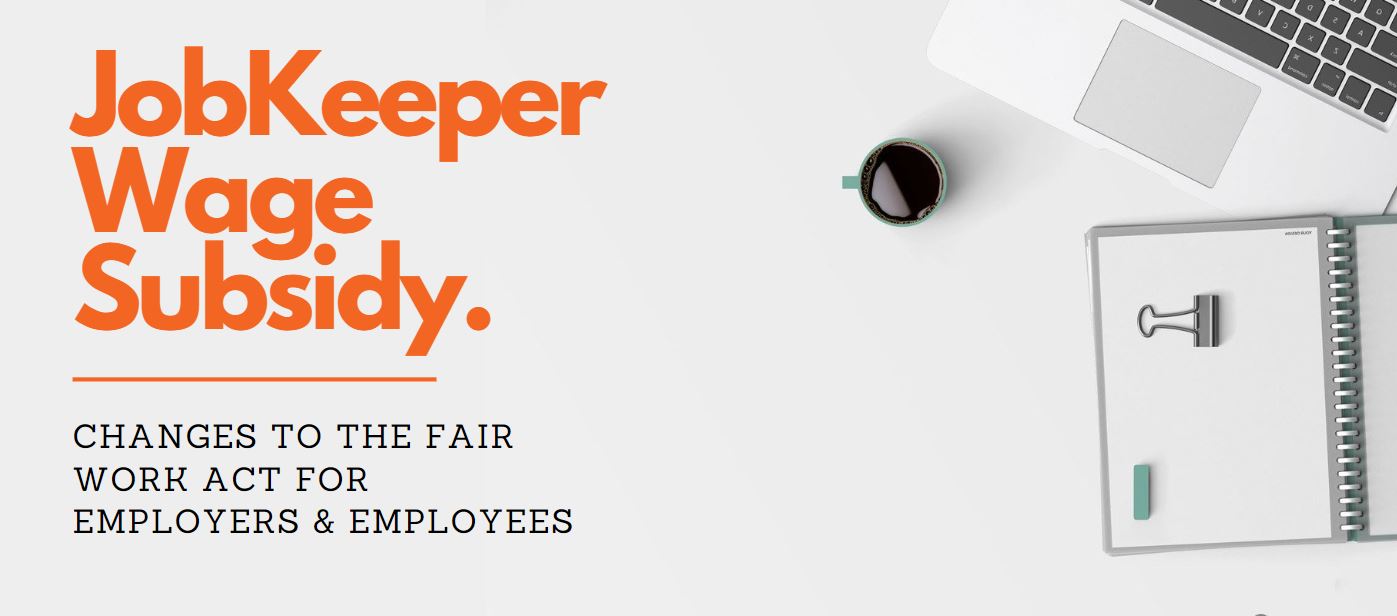JobKeeper Wage Subsidy – Changes to The Fair Work Act for Employers & Employees

The Federal Government has changed the Fair Work Act for employers and employees who have accessed the JobKeeper wage subsidy.
The new laws override any modern award, enterprise agreement or employment contract.
Under the new laws an employer can:
- Stand down an employee without pay (completely or partially) for any period that they cannot be usefully employed.
- Change employment arrangements (such as what they do, where they work and when they work) for a specific employee.
- WHAT IS THE JOBKEEPER WAGE SUBSIDY?
The JobKeeper wage subsidy is a $1,500 fortnightly payment to subsidise wages of eligible employees.
Employers must have a revenue reduction of 30% to access the subsidy (or 50% for businesses with a turnover of $1bn or more).
Employers are able to register with the Australian Taxation Office.
Here’s more on how to apply.
Employers can register their interest at the ATO Job Keeper webpage.
- WHAT ARE THE NEW STAND DOWN PROVISIONS?
The new stand down provisions allows an employer to give a direction (called a JobKeeper enabling stand down direction) to an employee to:
- Not work on a day or days on which the employee would usually work.
- Work for a lesser period than the period which the employee would ordinarily work on a particular day or days.
- Work a reduced number of hours (compared with the employee’s ordinary hours of work),
and not be paid for the period that work is not performed.
An employer can do this provided that:
- When the direction is given the employer qualified for the JobKeeper scheme.
- For the period of the stand down the employee cannot be usefully employed for the employee’s normal days or hours because of changes to business attributable to the COVID-19 pandemic or Government initiatives to slow the transmission of COVID-19.
- The implementation of the stand-down direction is safe and specifically safe having regard to the nature and spread of COVID-19.
- The employer becomes entitled to one or more JobKeeper payments for the employee for the period that the JobKeeper direction applies.
- The “wage condition” is satisfied (explained below).
- The minimum payment guarantee is met (explained below).
- The hourly rate of pay guarantee is met (explained below).
How do I know an employee cannot be usefully employed?
This situation arises when an employee has no (or a reduced level of) useful work available to perform because of the COVID-19 pandemic or because of the Public Health Orders and Directions (however described in each State and Territory) imposing restrictions on individuals and businesses.
Useful work does not have to be the work that the employee ordinarily performs but needs to be genuine productive work that provides a “net benefit” to the employer.
You should be able to demonstrate that the impacts of the virus or the Government’s measures to deal with it have caused the fact that there is none, or less useful, work available.
What is the wage condition?
Essentially it means the employer:
- Qualifies for the JobKeeper scheme.
- Is entitled to JobKeeper payments for an employee and otherwise complies with the Coronavirus Economic Response Package (Payments and Benefits) Act 2020. Compliance will involve “Rules” yet to be announced by the Government through the ATO.
What is the Minimum Payment Guarantee?
If a JobKeeper payment is payable to an employer for an employee for a fortnight, the employer must ensure that the total amount payable to the employee in respect of the fortnight is not less than the greater of the following:
- The amount of JobKeeper payment payable to the employer for the employee for the fortnight.
- The amounts are payable to the employee in relation to the performance of work during the fortnight.
What do “amounts payable” include?
This includes the following if they become payable in respect of the fortnight:
- Incentive-based payments and bonuses.
- Monetary allowances.
- Overtime or penalty rates.
- Leave payments.
What is the “hourly rate of pay guarantee”?
If a stand down direction is given by an employer to an employee, the employer must ensure that the hourly base rate of pay is not less than the rate that usually applies to the employee (as if the direction had not been given to the employee).
If an employer has directed the employee to perform different duties to normal (explained below) the employer must ensure that the employee’s hourly base rate of pay is not less than the greater of the following:
- The hourly base rate of pay that would have been applicable to the employee if the direction had not been given to the employee.
- The hourly base rate of pay that is applicable to the duties the employee is performing.
What is the “hourly base rate”?
The hourly base rate is the rate of pay payable for an employee’s ordinary hours of work, without any additional allowances, loadings or penalties added.
If the employee is not paid hourly, the hourly base rate of pay will generally be determined by:
- The provisions of any applicable industrial instrument (e.g. a modern award or enterprise agreement).
- Where no industrial instrument applies, dividing the payment made in each pay cycle by the number of ordinary hours in the period (again, minus any additional allowances, loadings or penalties added).
Further advice should be sought regarding this issue where unique payment arrangements exists with varying numbers of ordinary hours in each pay cycle.
When does a stand down direction not apply?
A stand down direction does not apply to the employee during a period when the employee is:
- Taking paid or unpaid leave that is authorised by the employer.
- Otherwise authorised to be absent from the employee’s employment.
- WHAT ARE THE WORKFORCE FLEXIBILITIES AN EMPLOYER CAN USE BY DIRECTION?
There are two scenarios to understand:
1) Direct an employee to perform different duties to normal.
An employer can give this JobKeeper direction provided that:
- The duties are within the employee’s skill and competence.
- When the JobKeeper direction is given the employer qualified for the JobKeeper scheme.
- The duties to be performed are generally safe and specifically safe having regard to the nature and spread of COVID-19.
- The employee holds any necessary licence or qualification required to perform the duties.
- The duties are reasonably within the scope of the employer’s business operation.
- The employer becomes entitled to one or more JobKeeper payments for the employee for the period that the JobKeeper direction applies.
2) Direct an employee to perform duties at a place different to their normal work place including the employee’s home.
An employer can give this JobKeeper direction provided that:
- The place is suitable for the employee’s duties.
- When the JobKeeper direction is given the employer qualified for the JobKeeper scheme.
- The performance of the duties at that place are generally safe and specifically safe having regard to the nature and spread of COVID-19.
- The performance of the duties at that place is reasonably within the scope of the employer’s business operation.
- The employer becomes entitled to one or more JobKeeper payments for the employee for the period that the JobKeeper direction applies.
What test applies to giving these directions?
The test requires that any of these directions can only apply if the employer has information before them that leads them to reasonably believe that the JobKeeper direction is necessary to maintain the employment of the employee.
To explain this further, there are three elements to this:
1) Information before the employer
The belief needs to be based on “information”. This cannot be a simple whim or a view based on nothing. There needs to be some form of factual material before the employer.
2) Reasonable belief
Reasonable belief is just that. The belief must be available on the information the employer has before them and needs to be reasonably available.
3) Necessary to maintain the employment of the employee
The best way to describe this is to apply what lawyers call a “but for” test.
But for you doing this (directing different duties or a different work location) the employee would be made redundant.
This is a quite high test and requires more than the JobKeeper direction being desirable or preferred but “necessary” to avoid this.
- DO ANY OTHER TESTS APPLY TO GIVING A JOBKEEPER DIRECTION?
Yes, there is a general overarching requirement that applies to:
- Directing an employee to stand down without pay (fully or partially).
- Directing an employee to perform different duties.
- Directing an employee to work on different days.
These directions do not apply to the employee if the JobKeeper direction is unreasonable in all of the circumstances.
What does “unreasonable in all of the circumstances” mean?
This is a very broad test and requires a consideration of anything relevant including the personal circumstances of the employee concerned.
Remember, there are varying degrees to which an act might be reasonable. There is no obligation on an employer to act in the most reasonable way available. What is important, however, is that a Court or Tribunal considering any direction does not consider the act to be unreasonable.
- WHAT ARE THE WORKFORCE FLEXIBILITIES AN EMPLOYER CAN USE BY REQUEST AND AGREEMENT?
There are two:
1) Request the employee to perform duties on different days and at different times compared to the employee’s normal ordinary hours of work.
An employer can request an employee to perform duties on different days and at different times compared to the employee’s normal ordinary hours of work provided that:
- The employer requests the employee to do so.
- The employee must consider and not unreasonably refuse the request.
- The employer qualified for the JobKeeper scheme.
- The performance of the duties on those days is generally safe and specifically safe having regard to the nature and spread of COVID-19.
- The performance of the duties on those days is reasonably within the scope of the employer’s business operation.
- The employer becomes entitled to one or more JobKeeper payments for the employee for the period that the days or hours are worked.
2) Direct an employee to take paid annual leave.
- An employer can request an employee to take paid annual leave provided that:
- The employer requests the employee to do so.
- The employee must consider and not unreasonably refuse the request.
- The employer qualified for the JobKeeper scheme.
- The employee will maintain a balance of paid annual leave of no fewer than two weeks.
- The employer becomes entitled to one or more JobKeeper payments for the employee for the period of the leave.
Payment for the leave
Payment for the leave is based on the rate of pay that applied before the JobKeeper legislation operated.
Double leave on half pay
The employer and employee can agree to take double the paid annual leave at half pay. By way of example, an employer and employee can agree to four weeks leave being taken, but the employee only has two weeks annual leave deducted and is only paid for two weeks annual leave
- WHAT ARE THE CONSULTATION OBLIGATIONS?
Before you give a JobKeeper direction the employer must:
- Give the employee written notice of the intention to give the JobKeeper direction at least three days before the JobKeeper direction is given or a lesser period if agreed with the employee.
- Consult with the employee (or a representative of the employee) about the direction.
The “notice” might be in a prescribed form. It is not yet clear whether a form will be prescribed by the Government.
- Conclusion
The amendments are intended to be temporary and will be subject to a review process commencing the end of July 2020.
If you’d like to discuss your business situation please contact us on 02 4228 4877 or at info@Journey2.com.au




